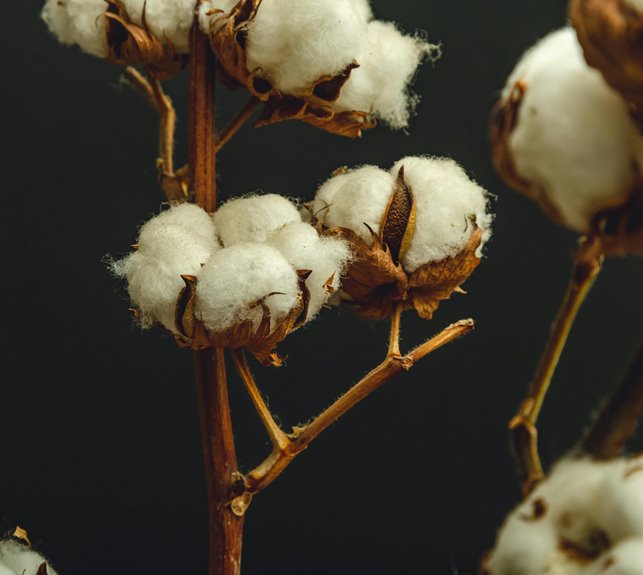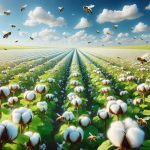When it comes to choosing between natural and synthetic fibers, the sustainability debate can get quite complex. You might think natural fibers are always the better option, but factors like resource use and environmental impact often tell a different story. On the flip side, synthetic fibers offer durability yet come with their own set of challenges. So, how do you decide which path to take for a more sustainable future? Let’s explore the nuances.
Table of Contents
Key Takeaways
- Natural fibers, like organic cotton and hemp, promote sustainability through reduced chemical use and improved soil health compared to conventional farming practices.
- Synthetic fibers, while durable, have a significant environmental impact due to energy-intensive production and microplastic pollution from washing.
- Natural fibers are generally biodegradable and compostable, returning nutrients to the soil, whereas synthetic fibers can take centuries to decompose.
- The performance characteristics of fibers vary, with natural fibers excelling in breathability while synthetic fibers outperform in moisture-wicking and durability.
- Supporting sustainable practices in both natural and synthetic fiber production, such as water-efficient irrigation and recycling, is essential for minimizing environmental footprints.
Environmental Impact of Natural Fibers
While natural fibers like cotton, wool, and hemp offer a sustainable alternative to synthetic options, their environmental impact can vary considerably based on cultivation practices.
Natural fibers such as cotton, wool, and hemp can be sustainable, but their ecological effects depend on farming practices.
For instance, conventional cotton farming often involves heavy pesticide use and significant water consumption, straining local ecosystems. In contrast, organic cotton or hemp farming typically employs more sustainable methods, reducing chemical runoff and conserving water.
Wool, sourced from sheep, can have mixed impacts depending on grazing practices; overgrazing can lead to soil degradation, while responsible farming can enhance biodiversity.
Furthermore, the processing of these fibers can also contribute to their overall environmental footprint.
Environmental Impact of Synthetic Fibers
Although synthetic fibers like polyester, nylon, and acrylic offer durability and versatility, their environmental impact can be significant.
These materials often contribute to pollution and waste, affecting both land and marine ecosystems. When you choose synthetic fabrics, it’s crucial to reflect on their long-lasting effects.
- Microplastic Pollution: Washing synthetic garments releases tiny plastic fibers that enter waterways, harming aquatic life.
- Non-Biodegradability: Synthetic fibers can take hundreds of years to decompose, leading to increased landfill waste.
- Energy-Intensive Production: The manufacturing process for these fibers usually relies on fossil fuels, contributing to greenhouse gas emissions.
Being aware of these impacts helps you make more sustainable choices in your wardrobe.
Resource Use in Fiber Production
When you think about fiber production, consider how much land and water it requires.
Natural fibers often rely on extensive agricultural practices, while synthetic fibers come with their own resource challenges.
Understanding these factors is essential for evaluating sustainability in the textile industry.
Land and Water Usage
As you explore the differences between natural and synthetic fibers, understanding land and water usage becomes vital. The impact of fiber production on our planet varies markedly between these two types.
Natural fibers, like cotton and wool, often require vast amounts of land and water for cultivation, leading to potential environmental strain. In contrast, synthetic fibers, such as polyester, are made from petrochemicals and can require less water but still demand considerable energy resources for production.
Consider these points:
- Natural fibers can lead to soil depletion and pesticide runoff.
- Synthetic fibers may contribute to microplastic pollution in water systems.
- Efficient practices in both categories are essential for minimizing their environmental footprints.
Being informed helps you make better choices for sustainable fashion!
Resource Sustainability Challenges
While both natural and synthetic fibers present unique sustainability challenges, the resource use in their production greatly impacts the environment.
For natural fibers like cotton, you’re often facing issues like pesticide use and water depletion. Growing these crops can strain local ecosystems, and the demand for organic practices can be limited.
On the other hand, synthetic fibers, such as polyester, rely on fossil fuels, contributing to greenhouse gas emissions and resource depletion. Their production process also requires significant energy and water.
Biodegradability and End-of-Life Considerations
Understanding the biodegradability and end-of-life reflections of fibers is essential, especially as consumers become more environmentally conscious.
You should know how different fibers behave once they reach the end of their useful life. Natural fibers, like cotton and wool, often break down more easily in the environment, returning nutrients to the soil.
In contrast, synthetic fibers, such as polyester, can take hundreds of years to decompose, posing long-term pollution risks.
Here are some key points to reflect on:
- Natural fibers: Generally biodegradable and compostable.
- Synthetic fibers: Often non-biodegradable, leading to landfill accumulation.
- Recycling options: Some synthetic fibers can be recycled, reducing waste impact.
Energy Consumption and Emissions Comparison
When you compare natural and synthetic fibers, energy consumption and emissions play an essential role in your decision-making.
You’ll want to take into account how energy-efficient each type is and the greenhouse gas emissions they produce.
Additionally, analyzing the transportation footprint can help you understand the overall environmental impact of your fiber choices.
Energy Efficiency Comparison
How do natural and synthetic fibers stack up regarding energy efficiency? When you consider the production processes, you’ll find significant differences.
Natural fibers, like cotton and wool, typically require less energy to produce compared to synthetic fibers, which are derived from petroleum. However, the overall energy efficiency can vary based on farming practices and manufacturing methods.
- Natural fibers often involve renewable resources, reducing energy input.
- Synthetic fibers can require substantial energy for extraction and processing.
- Innovations in recycling synthetic fibers are improving their energy efficiency.
Greenhouse Gas Emissions
While both natural and synthetic fibers play significant roles in the textile industry, their greenhouse gas emissions reflect stark differences in their production processes.
Natural fibers like cotton and wool generally emit lower greenhouse gases since they require less energy to produce. However, their cultivation can still lead to significant emissions if pesticides and fertilizers are used excessively.
On the other hand, synthetic fibers, such as polyester and nylon, often result in higher emissions due to the energy-intensive extraction of fossil fuels and the manufacturing processes involved.
Transportation Footprint Analysis
As you consider the overall environmental impact of textiles, the transportation footprint is essential in understanding energy consumption and emissions. The journey from production to consumer can greatly affect sustainability.
Natural fibers often rely on local sources, reducing transport distances, while synthetic fibers frequently travel long distances from factories. This discrepancy can lead to higher energy consumption and emissions for synthetics.
Here are some key points to keep in mind:
- Local Sourcing Benefits: Natural fibers sourced nearby minimize transportation impacts.
- Carbon Footprint Variability: Different transport methods (air, sea, land) produce varying emissions.
- End-of-Life Logistics: The transportation of discarded materials also contributes to the overall footprint.
Social and Economic Factors in Fiber Sourcing
What influences your choices when sourcing fibers for clothing or textiles? Social and economic factors play a huge role.
You might consider the labor practices involved in fiber production—are workers treated fairly and paid a living wage? Sustainable sourcing often means prioritizing ethical brands that support local economies and promote fair trade.
Additionally, the environmental impact of fiber production can affect your decision. Natural fibers often rely on traditional farming methods that can boost local communities, while some synthetic fibers may come from large-scale operations with questionable practices.
Performance and Functional Differences
When choosing between natural and synthetic fibers, understanding their performance and functional differences can greatly impact your decision.
Each type has unique characteristics that can affect comfort, durability, and maintenance.
- Breathability: Natural fibers like cotton and linen excel in breathability, keeping you cool in warm weather.
- Moisture Wicking: Synthetic fibers such as polyester and nylon often outperform natural options in moisture-wicking capabilities, making them ideal for athletic wear.
- Durability: Synthetic fibers generally offer greater durability and resistance to wear, while natural fibers may provide a softer feel but can be less long-lasting.
Sustainable Practices in Natural Fiber Production
Natural fibers not only offer comfort and breathability but also come with the potential for sustainable practices that can benefit the environment.
When you choose natural fibers, like organic cotton or linen, you support farming methods that avoid harmful pesticides and synthetic fertilizers. These practices help preserve soil health and reduce water pollution.
Choosing natural fibers like organic cotton and linen supports sustainable farming and protects our precious ecosystems.
Crop rotation and polyculture further enhance biodiversity, making ecosystems more resilient. Additionally, many producers adopt water-efficient irrigation techniques, minimizing waste.
By supporting local artisans and fair-trade producers, you’re promoting ethical labor practices and reducing carbon footprints related to transportation.
You can also encourage the use of renewable resources in fiber processing, ensuring that the entire production cycle aligns with sustainability goals.
Choose wisely and make a positive impact.
Innovations in Synthetic Fiber Sustainability
As the demand for synthetic fibers continues to rise, innovative approaches are emerging to enhance their sustainability.
You’ll find that companies are increasingly focusing on reducing environmental impact through various methods. These innovations not only help in creating a more sustainable product but also attract eco-conscious consumers.
- Recycled Materials: Brands are using post-consumer plastics and other recycled materials to produce new fibers, minimizing waste.
- Biodegradable Options: Advances in technology have led to the development of biodegradable synthetic fibers that break down more easily in the environment.
- Waterless Dyeing Techniques: New dyeing processes that eliminate water usage are being implemented, reducing the overall ecological footprint of textile production.
These strategies show promising potential for a greener future in the synthetic fiber industry.
Frequently Asked Questions
What Are the Most Common Natural Fibers Used in Textiles?
You’ll find cotton, wool, linen, and silk as the most common natural fibers in textiles. Each offers unique properties, making them popular choices for clothing, home goods, and various other fabric applications.
How Can Consumers Identify Sustainable Fiber Products?
You can identify sustainable fiber products by checking labels for certifications, researching brands’ practices, and prioritizing transparency. Look for eco-friendly materials, and support companies committed to ethical sourcing and environmentally responsible production methods.
Are There Certifications for Sustainable Fiber Sourcing?
Yes, there are certifications for sustainable fiber sourcing. Look for labels like GOTS, OEKO-TEX, or the Global Recycling Standard. These certifications guarantee that the fibers meet specific environmental and social standards, helping you make informed choices.
What Role Does Recycling Play in Fiber Sustainability?
You’ll find recycling plays an essential role in fiber sustainability. By reusing materials, you reduce waste and lower resource consumption. It’s a smart way to support a circular economy and minimize environmental impact.
How Do Climate Change Impacts Affect Fiber Production?
Climate change impacts your fiber production by altering weather patterns and water availability. Increased temperatures can threaten crop yields and quality, while extreme weather events disrupt harvesting, affecting both natural and synthetic fiber supply chains.
- Does Soaking Clothes in Salt Water Stop Dye Bleeding? - June 10, 2025
- How to Prevent Fabric Bleeding in Handmade Garments - June 10, 2025
- The Best Method to Stop Blue Jeans From Bleeding Dye - June 10, 2025




